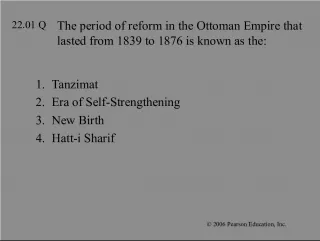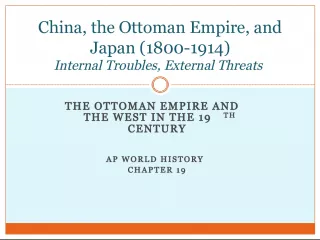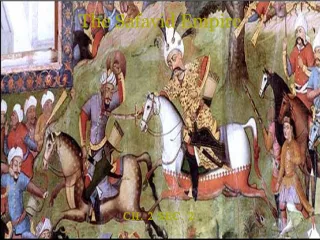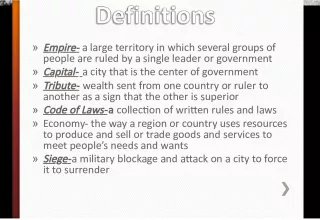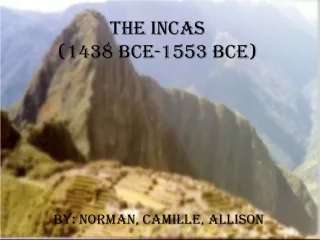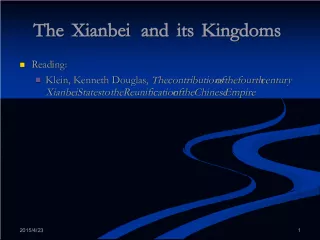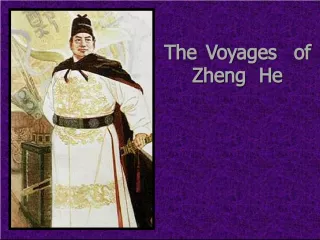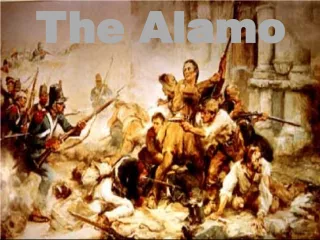The Ottoman Empire: Building a Vast Muslim World
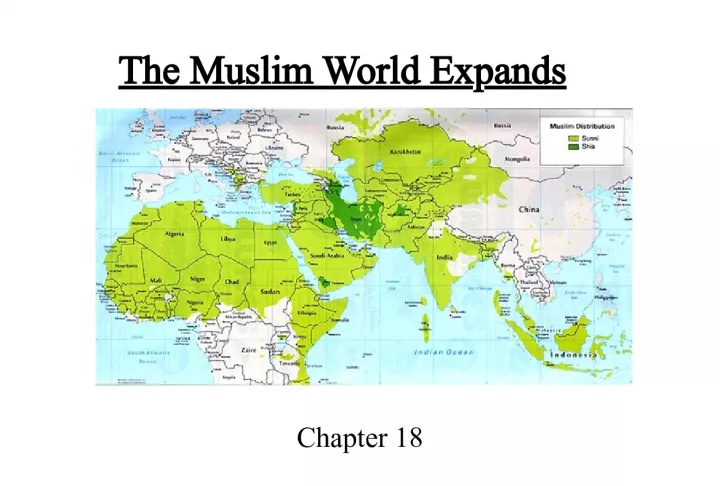

In Chapter 18, Section 1, we explore the rise of the Ottomans - a group of Anatolian Turks who saw themselves as warriors for Islam. Known as
- Uploaded on | 0 Views
-
 yusuf
yusuf
About The Ottoman Empire: Building a Vast Muslim World
PowerPoint presentation about 'The Ottoman Empire: Building a Vast Muslim World'. This presentation describes the topic on In Chapter 18, Section 1, we explore the rise of the Ottomans - a group of Anatolian Turks who saw themselves as warriors for Islam. Known as. The key topics included in this slideshow are . Download this presentation absolutely free.
Presentation Transcript
Slide1The Muslim World ExpandsChapter 18
Slide9Section 1-The Ottomans Build a VastEmpire
Slide10The Turks Move into Byzantium• Ghazis • Ghazis -Anatolian Turks that saw themselves as warriors for Islam • Ottomans • Ottomans -Followers of Osman the most successful ghazi gun powder – Military Success based on gun powder cannons – Some of the 1 st people to use cannons
Slide11The Turks Move into Byzantium• Sultan • Sultan -Meaning ‘overlord’ or “one with power” • Living under the Ottomans local officials – Used local officials appointed by the sultan to rule conquered areas – Muslims – Muslims served in the Turkish army and pay religious taxes tax – Non-Muslims did not have to serve in the army but paid a small tax in return
Slide12The Turks Move into Byzantium• Timur the Lame- – Received the nickname after taking an arrow to the leg Baghdad – Burned Baghdad to the ground Ottomans – Crushed the Ottomans in the Battle of Ankara (1402)
Slide13Powerful Sultans Spur DramaticExpansion • Mehmed II- Mehmed the Conqueror – Nicknamed Mehmed the Conqueror Constantinople – Attacked Constantinople • Fired a 1,200lb bolder out of a 26-foot gun and ships Istanbul • After conquering the city he renamed it Istanbul opened it up to Christians, Jews, Muslims, Turks and non- Turks
Slide14Powerful Sultans Spur DramaticExpansion • Suleyman the Lawgiver- – Ruled for 46 years bureaucratic – Created penalties for various criminal acts, bureaucratic and financial corruption balanced budget – Also introduced the concept of a balanced budget to governments
Slide15Powerful Sultans Spur DramaticExpansion • Suleyman the Lawgiver- mathematics – Studied poetry, history, geography, astronomy, mathematics and architecture tolerant – Because of Islamic law he was tolerant of other religions literature – Supported art and literature
Slide16Powerful Sultans Spur DramaticExpansion Christian • Devshirme System-Members of the sultan’s army drafted from the Christian boys of conquered territories. – Converted educated – Converted to Islam, and educated them the sultan • Janissaries-Elite force of 30,000 soldiers trained to be loyal only to the sultan .
Slide17Section 3-The Mughal Empire in India
Slide19Early History of the MughalsMongols • Mughals-Means Mongols nomadic – Group of nomadic invaders in Central Asia Babur • 1494- Babur inherits the kingdoms of Uzbekistan and Tajikistan at the age of 11 Mughal Empire – Swept down into India and laid the foundations for the Mughal Empire
Slide20Early History of the Mughals• Akbar-Ruled India from 1556 to 1605 grandson – Babur’s grandson tolerance – Ruled with wisdom and tolerance Divine Faith – Created his own religion the “ Divine Faith ” revolt • He offended Muslims so much that they tried to revolt against him in 1581
Slide21Early History of the Mughals• Art and Literature- – Illustrated books – Illustrated books flourished • Miniatures • Miniatures -Small highly detailed, colorful paintings – Hindu literature – Hindu literature also saw a resurgence during Akbar’s time
Slide22Akbar’s Successors• Shah Jahan- – Killed – Killed anyone who got in his way of being king – Had two great passions in life: buildings • Beautiful buildings • His wife Mumtaz Mahal – Sadly she died at age 39 while giving birth to their 14 th child
Slide23Akbar’s Successors• Taj Mahal- Mumtaz Mahal • Taj Mahal- Towering marble dome built as a memorial to Mumtaz Mahal following her death most beautiful building – Referred to as the most beautiful building in the world
Slide25Akbar’s Successors• Aurangzeb- Shah Jahan’s 3 rd son – Took power when Shah became sick greatest size – Expanded the Mughal Empire to it’s greatest size – Oppressed the people sharia • Strict Islamic law ( sharia ) banned gambling, drinking, and other vices non-Muslims Hindus • Taxed non-Muslims and was cruel to Hindus
Slide26The Empire’s Decline and Decay• Reasons for the Empire’s Decline- – Aurangzeb had drained it’s resources hunger – 2 million people died of hunger local lords – As central power weakened the power of local lords grew western traders – The power of western traders began to increase
